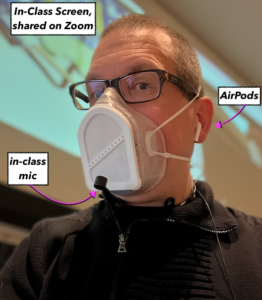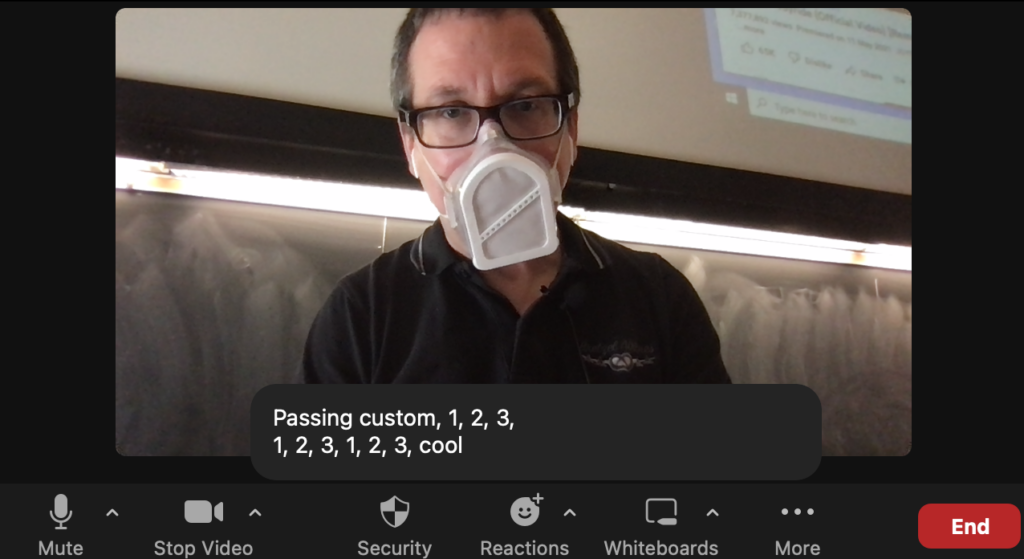
I've been teaching large lectures for many years. After the initial remote teaching phase of the pandemic management required most faculty to go back to in-person teaching. While most of my colleagues decided to do so maskless, I made the unpopular decision to wear N95+ respirators while teaching in class. Despite pushback on N95s from my employer, wearing an N95 or better is clearly the safest choice for pandemic teaching.. However, it poses a number of practical challenges, not the least of which is being understood while speaking.
So, I decided to bring remote teaching to my physical lecture hall.
These are my steps to setting up my class for simultaneous broadcasting. I
- Put on my N95 respirator
- Go to my classroom (with a Corsi-Rosenthal air cleaner, of course)
- Plug in my laptop to the over-head display system
- Wear the in-class wireless microphone
- Turn on the Zoom session on my laptop.
- Turn on the camera on my laptop to point to the white board
- Share the computer's display on Zoom
- Turn on captions
- Turn on my iPhone
- Open Zoom on my iPhone and connect to the class Zoom session
- Put AirPods in my ears
- Connect to Zoom with audio from my iPhone
- Put my phone in my pocket
- Teach from anywhere I want in the classroom
I've been doing this for well over a year. Here is a photo from when I was doing it with a P100 elastomeric respirator in the Winter of 2022.
From an accessibility perspective, this is a win-win for my students. First, my students can connect with class remotely -- super important, especially on a commuter campus like York's Keele campus. Second, students in the class can log in over Zoom and follow-along with the captioned audio. This is a big deal from an accessibility perspective. While I've heard that some people would like to see teacher faces in class, let's be honest: how well can a student sitting at the back of a classroom see a teacher's mouth moving? It's far better for that student to be able to see the captions than to try and make out the shape of my mouth.

For those worried that mask-wearing can diminish the sound coming out a teacher's mouth, well it's really not as bad as you might think. Many disposable N95s do a good job, as per my initial batch of sound tests posted here.
Now, clearly, this would be more straight forward if my employer had spent the last few years of the pandemic renovating the audio-visual equipment in all classrooms to permit simultaneous remote broadcasting. But that didn't happen and there is no plan in place to make that happen any time soon. So, like with most things, it's up to individual faculty to do the right thing while management ignores the continued reality of teaching in a pandemic. Bring on the ice cream socials, right?
So, if you've read this far, maybe you'd be interested in making our classrooms more accessible and reflective of the realities of technology-integrated teaching. If so, drop the folks in charge of classroom renovations a line. You can find out more here:

James Andrew Smith is a Professional Engineer and Associate Professor in the Electrical Engineering and Computer Science Department of York University's Lassonde School, with degrees in Electrical and Mechanical Engineering from the University of Alberta and McGill University. Previously a program director in biomedical engineering, his research background spans robotics, locomotion, human birth and engineering education. While on sabbatical in 2018-19 with his wife and kids he lived in Strasbourg, France and he taught at the INSA Strasbourg and Hochschule Karlsruhe and wrote about his personal and professional perspectives. James is a proponent of using social media to advocate for justice, equity, diversity and inclusion as well as evidence-based applications of research in the public sphere. You can find him on Twitter. Originally from Québec City, he now lives in Toronto, Canada.
